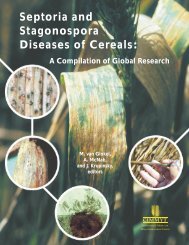Section 3 (Crop Management)
Section 3 (Crop Management)
Section 3 (Crop Management)
Create successful ePaper yourself
Turn your PDF publications into a flip-book with our unique Google optimized e-Paper software.
Proceedings of the 8 th Asian Regional Maize Workshop, Bangkok, Thailand: August 5-8, 2002<br />
Fertilizer <strong>Management</strong> Research in Maize in the Eastern Hills of Nepal<br />
R.B. Katuwal<br />
Nepal Agricultural Research Council<br />
Agricultural Research Station<br />
Pakhribas, Dhankuta, Nepal<br />
Abstract<br />
Decreased soil fertility, unbalanced use of organic and inorganic fertilizers, low adoption and<br />
adaptation of recommended dose of chemical fertilizers and less awareness of the application of fertilizers<br />
and management of soil fertility were the major problems in the mid hills of Nepal. A study on fertilizer<br />
management was carried out at mid altitude outreach research sites namely, Fakchamara and Belhara of<br />
Terhathum and Dhankuta districts respectively. The experiments were conducted in 2000 and 2001. The<br />
overall objective of these experiments was to identify the essential plant nutrients limiting maize yield<br />
and to determine the appropriate time of urea (nitrogen) application to achieve maximum maize<br />
production. Two trials were carried out. These were limiting plant nutrients on maize under maize/millet<br />
system and synchronizing nitrogen availability by split application on maize in the year 2000 and 2001.<br />
Two year’s results indicated that nitrogen was the most crucial and essential nutrients among the major<br />
plant nutrients for better maize production. The application of agri-lime (5 t/ha) in acidic soils showed<br />
encouraging effect on grain yield of maize, both years, in both sites, there was significant (P









